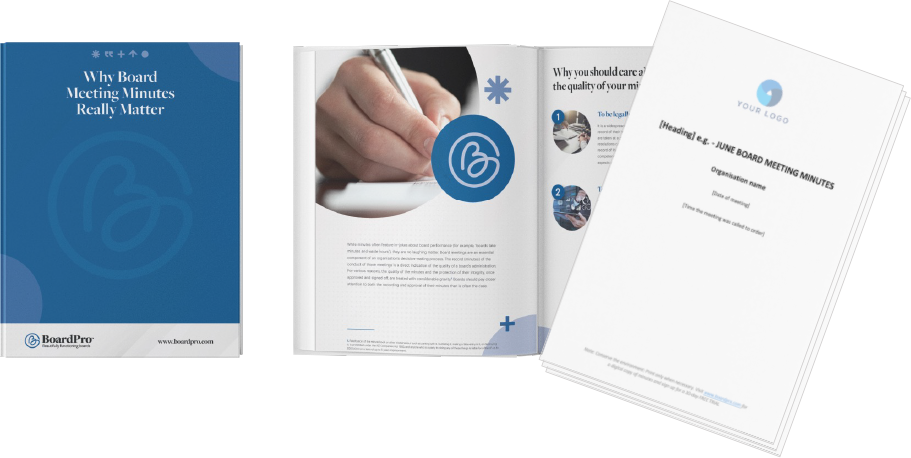How to create quality meeting minutes
Writing effective meeting minutes can be cumbersome and painful. BoardPro’s polling of governance pain points over the past three years shows that over 76% of respondents rated ‘minute taking’ as a significant pain point.
Minute takers for small-medium businesses and not for profit organisations are often ‘first timers’ or inexperienced. Many of these organisations struggle to establish a good structure and fall into misconceptions, such as needing to record the entire board meeting verbatim.
In this article, we'll explore:- why board minutes really matter
- what meeting minutes need to include
- why the quality of meeting minutes is important
- how to prepare meeting minutes
 Whilst we deliver training, we’re ongoing learners ourselves. We benefit from observing our client’s practices (when given permission to look) and draw from our own expert advisors such as Graeme Nahkies of BoardWorks. This article covers some of the main aspects of writing minutes and is based on one of Graeme’s own articles which we’ve adapted slightly and otherwise simply fleshed out with practical examples and links to related resources. Please note, however, that this commentary does not constitute legal advice. You should get specific legal advice if there is any uncertainty.
Whilst we deliver training, we’re ongoing learners ourselves. We benefit from observing our client’s practices (when given permission to look) and draw from our own expert advisors such as Graeme Nahkies of BoardWorks. This article covers some of the main aspects of writing minutes and is based on one of Graeme’s own articles which we’ve adapted slightly and otherwise simply fleshed out with practical examples and links to related resources. Please note, however, that this commentary does not constitute legal advice. You should get specific legal advice if there is any uncertainty.
Why board minutes really matter
Board meeting minutes are the guardrails that hold organisations accountable to decisions made by the organisations’ ultimate leadership body, the board of directors. In most jurisdictions it is a legal requirement of incorporated bodies to keep a written record of the board’s decisions by way of meeting minutes.
While minutes often feature in-jokes about board performance (for example, ‘boards take minutes and waste hours’), they are no laughing matter. Board meetings are an essential component of an organisation’s decision-making process. The record (minutes) of the conduct of those meetings is a direct indication of the quality of a board’s administration. For various reasons, the quality of the minutes and the protection of their integrity, once approved and signed off, are treated with considerable gravity. Boards should pay closer attention to both the recording and approval of their minutes than is often the case.
Save time and budget by using board management software for your minutes
What do you need to include in meeting minutes?
To begin with the basics. These include:
- The title of the meeting (e.g., board or committee)
- Date and time (including the time the meeting concluded)
- Venue and place
- Participation: noting who were the decision makers (e.g., directors) and confirm that a quorum existed. Noting also who were also ‘in attendance’ (staff, external advisors, observers, visitors, etc.) and those with specific roles in relation to the conduct of the meeting (e.g., chair, secretary/minute taker). Apologies should be recorded and declarations of interest in respect of matters on the agenda . Any changes in attendance during the meeting should also be noted (e.g., when a director leaves the room and returns).
- Meeting description (what business was dealt with and in what order , how it was handled (procedure, discussion, votes, etc.) and with what result (decisions).
As indicated previously, the minutes are not only a record of a board’s decisions but of the development of the board’s thinking about significant topics. Generally, minutes should aim to achieve a ‘Goldilocks’ kind of balance. They should be neither too long nor too short but the more important something is, the more thorough, and likely extensive, the minutes should be. A good test of any decision described in the minutes is whether someone who was not present can later see how and why the board arrived at its final position. Material that is influential in the board’s decisions on matters of substance should normally be included by reference or even attachment.
Minutes should also record that appropriate governance processes were observed. Having minutes record the steps taken encourages a higher level of compliance with agreed decision-making processes and protects both the board and an organisation’s stakeholders from shortcuts. If normally part of a board’s operating mode, parliamentary-style procedural motions and voting outcomes should be applied and accurately recorded, including votes in opposition to a motion and abstentions.
Usually, it is neither necessary nor advisable to note who said what. Directors are collectively accountable for a board’s final decisions whether those reflect their personal preferences or not. In reaching decisions members must be able to contribute to rigorous and meaningful discussions. They should be able to engage actively in the ebb and flow of board dialogue without consideration for how a view that is attributed to them (and which may change during the debate) might be received by any other potential audience.
While, ultimately, a director’s personal view on a matter is not relevant individual views can be heard and acknowledged without attribution. For example: “In considering the proposal the board reflected on a concern that the cash flow needed to fund the initiative might be insufficient if there was a further COVID-related lockdown. On balance, however, it felt that its present and prospective reserves would be sufficient to carry it through.”
The four key elements of meeting minutes
1. A Record of the Board Meeting & Key Decisions
The meeting minutes are not only a record of a board’s decisions but of the history and development of the board’s thinking about important matters. The more important something is, the more thorough the minutes with respect to it should be. Board meeting minutes should be written carefully but be balanced to ensure that they are neither too long nor too short. Legal advice has changed over the years. Once minimalist minutes (a record of decisions and not much else) were favoured. Today, more fulsome disclosure of a board’s thinking is considered appropriate. Apart from decisions, the minutes should include just enough to record the most important ingredients in the board’s thinking. It is normally neither necessary nor advisable to note who said what during the meeting. The objective is to document key information, the processes and meeting outcomes.
2. A Record of Procedural Matters
Board of directors’ minutes should be a record of procedural matters. Therefore, the minutes should disclose that the meeting has been duly constituted (e.g. that a quorum of members was present; that the minutes of your previous meeting were approved; date and time of next meeting, etc.) and adjourned and that applicable procedural steps have been taken.
3. A Record of Governance Process
Minutes should also record that appropriate governance processes were observed. Proof of the extent to which directors adhered to good standards of practice may become important in some circumstances.
Because it is difficult to hold directors individually and collectively accountable when decision-making processes are either not in place or are ignored, process minutes encourage a higher level of accountability and protect both the board and its stakeholders. Documents that form an important part of the board's decision-making should be referenced or even attached.
4. Declarations of Conflicts of Interest
Finally, declarations of directors’ interests (or of any other participant in the board's decision-making process) should be disclosed in the minutes. This should be accompanied by a record of the action taken to manage or mitigate any conflicts of interest. An example might be if an interested party withdraws from the meeting while a matter is discussed and resolved.
Download our minutes guide and word template
Why is the quality of meeting minutes important?
1. To be legally compliant
It is a widespread legal requirement for incorporated bodies to keep a written record of their boards’ decisions. This requirement applies whether decisions are taken at a properly convened meeting or ‘between meetings’ using circular resolutions or ‘flying minutes’.
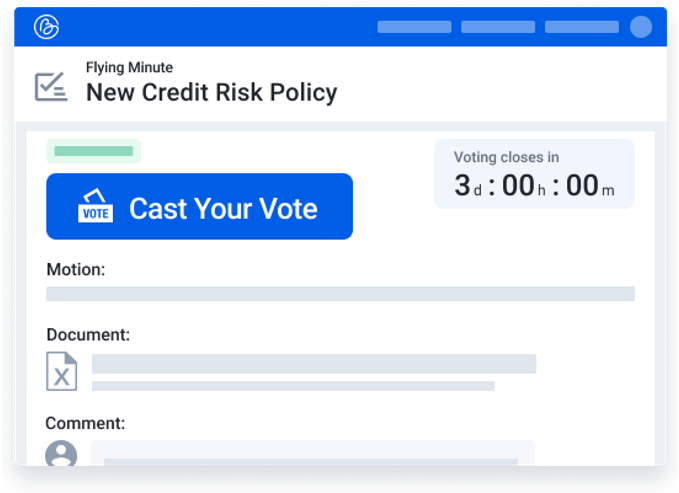
Failure to keep an adequate record of its proceedings might be taken as a worrying sign not only of the board’s competence but of its integrity. Inadequate minutes may also compromise some aspects of a corporate entity’s legal protections (e.g., of limited liability) .
2. To demonstrate the integrity of process
Minutes are a record of important organisational transactions. While an enduring record of its deliberations is primarily for the benefit of the board itself, minutes are also increasingly important to third parties. For example, when minutes are described as ‘a letter to a judge’ it acknowledges their importance in special inquiries or litigation when board decisions (or a lack of them) are under the microscope. Minutes are a significant component in a ‘paper trail’ that can help prove, for example, that proper authority was exercised, and correct procedure was followed.
The process of producing minutes is as important as what they contain. That is why, for example, after minutes have been approved and signed by the chair as a true and correct record they should not be altered. If there is subsequent disagreement with a decision, and the board has second thoughts, it is not the minute book that should be changed, but the decision - at a subsequent meeting.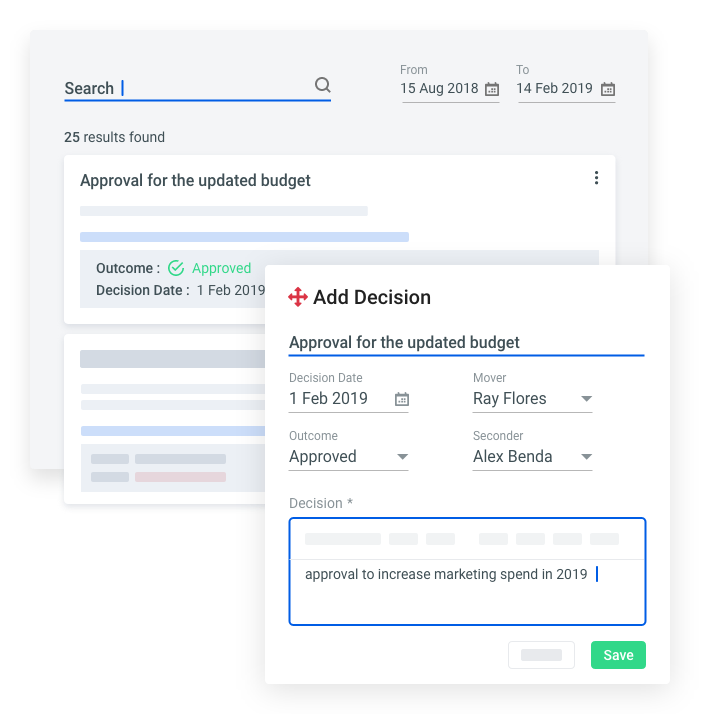
Typically, in a legal contest the other side has to prove that a board’s minutes are not correct. In a dispute, for example, about whether a board acted in compliance with applicable legal and contractual requirements, the courts will accept the board’s minutes as the best record of its decision and the basis on which it was made. But, if that record is inadequate - if, for example, it is too cryptic - the board may be faced with a judicial conclusion that it had not properly decided the matter.
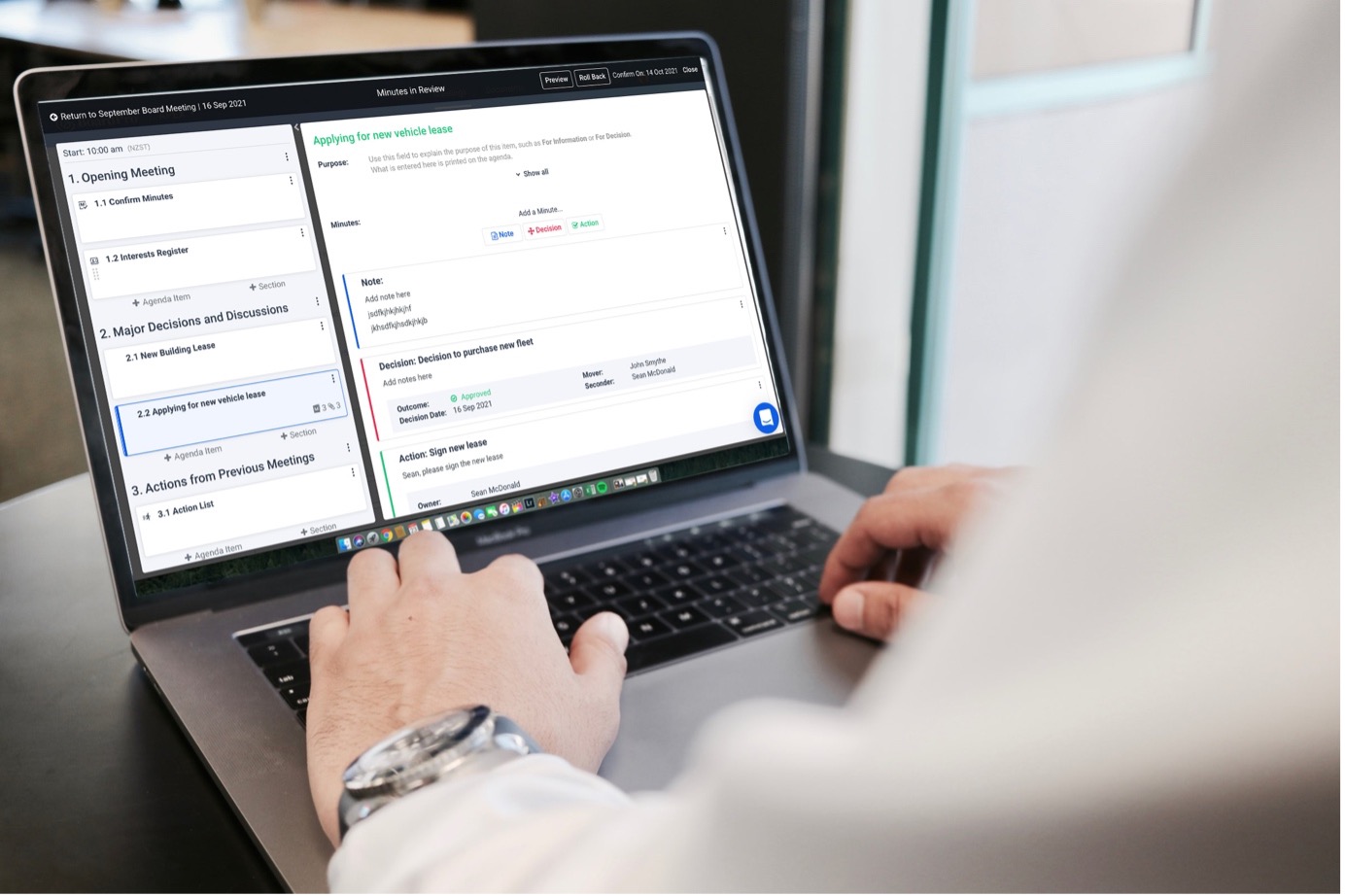
3. To protect organisational and director reputation
Boards frequently have to deal with potential conflicts of interest. Handling these with care is essential to protecting the reputation and the integrity of the organisation and individual directors who may later be vulnerable to accusations that they have misused their positions. Minutes should accurately and thoroughly record the process steps taken (e.g., full disclosure of the actual or potential conflict and the extent to which a potentially conflicted director is involved, if at all, in the decision making process).
4. As a basis for decision evaluation and review
Historically, legal advice was to keep minutes to a record of decisions so that a board’s decision making process was not exposed. Current thinking is the complete opposite - that the best defence for a board whose decisions are questioned is to have documented the diligence and thoroughness that was applied. Boards need to be able to demonstrate that, for example, they received sufficient information and advice from reasonable sources, that such information and advice was properly interrogated, and that appropriate discussion occurred before the board made its final choice.
Minutes that record the thinking on which a decision was based, are also an important starting point for the board’s own post-decision evaluations. If, for example, a project the board approved did not meet expectations, were there flaws in the original decision making process or its subsequent implementation oversight that it could learn from?
Because board and executive team members change over time, minutes are also useful when current board and management teams want to understand why, for example, a longstanding policy which now has no apparent purpose, was adopted. They should expect to be able to find information on the objectives, and the assumptions on which the policy was originally based, in past minutes and attached papers.
5. To clarify responsibility and track action
The content of board minutes frequently contains details of the assignment of responsibility for further action on a variety of the matters that were discussed. Whether this assignment is to officers of the board (e.g., the chair or a committee), or to the chief executive, documenting accountability in the minutes creates an implementation tracking reference point. For greater visibility and easier access, this kind of minute content is often copied into a separate action list. Nevertheless, the starting point is what was recorded in the minutes.
6. To facilitate due diligence
Auditors have an obvious interest in a board’s minutes, but board records are also an important source of information for others who may be entitled to access board records. For example, directors considering joining the board would want to know about potential risks and liabilities. In a sales process a prospective purchaser, and in a merger situation a potential partner, may have similar interests.
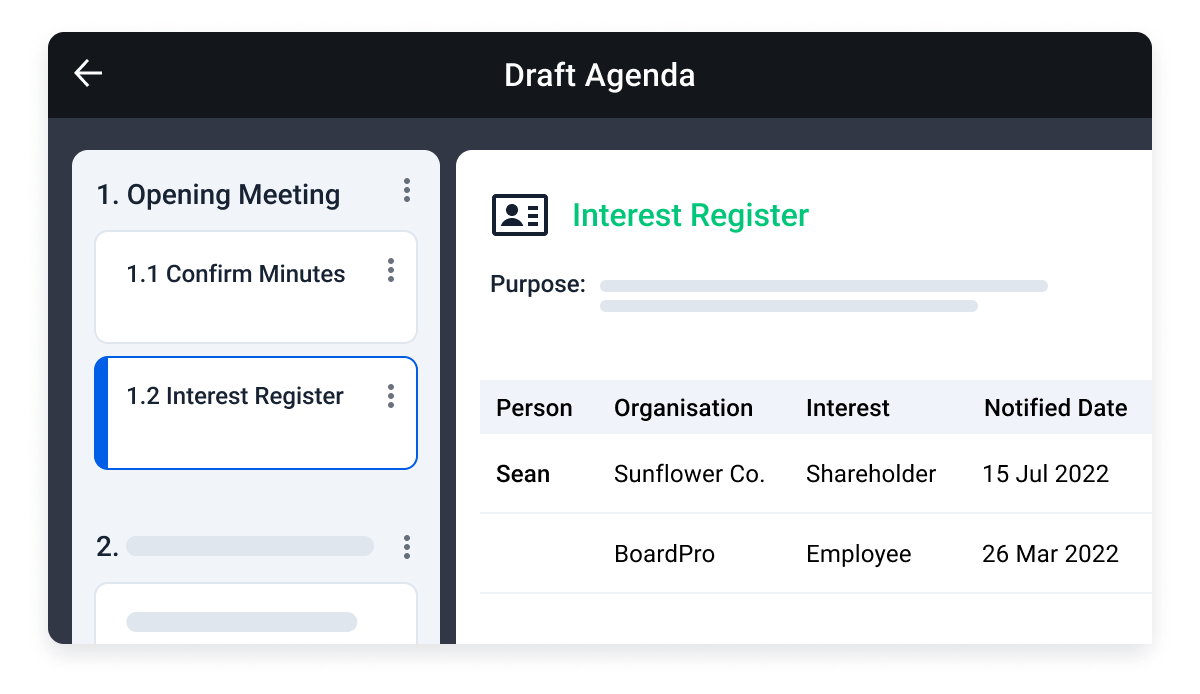
If it turns out there are significant errors or omissions, or if the minutes are misleading, it may lead to trouble for those who approved the original minutes.
7. As a record of an organisation’s history
We should also acknowledge the broader value of minutes in terms of historical research. Few organisational histories are written without extensive reliance on the minutes of past board meetings as a primary source. As board minutes are recorded so is an organisation’s longer-term history being recorded.
Similarly, board minutes can play a very important part in the induction of new directors and senior executives. Minutes often hold the key to a new director’s or a new chief executive’s understanding of the origins of current issues and even pointers to future challenges.
Learn the 7 factors that lead to successful board meeting minutes
Preparing meeting minutes
In an ideal world every board would have a competent scribe assigned the task of taking the minutes. Someone who is not required to contribute to the content of the meeting but who understands the business and has solid experience of governance. This is not always the case. In smaller and less well-resourced organisations the task may by default fall to a board member who is otherwise actively involved in the meeting, or even a relatively junior and inexperienced staff member.
Minutes should be clearly written, balanced, and impartial, and not least, accurate. If just one set of minutes is wrong, it throws doubt upon any other minutes that the board may later need to rely on. No matter who has prepared the draft minutes nor in what circumstances, particular care needs to be taken in reviewing the first draft. One risk, if the draft minutes have been prepared by anyone who has participated in the meeting, is the temptation to write up the meeting as they thought it should have occurred rather than as it did.
Generally, the initial review (and, if necessary, correction) of draft minutes should be undertaken by the board chair. Then the draft should be sent to all directors inviting (and expecting) them to identify any discrepancies or errors. It is an opportunity for them to check against any notes they may have made themselves.
A further, penultimate (but still draft) version of the minutes, approved by the chair, can be circulated to those who need to take follow-up action on anything before the minutes are approved.
The final step is for the draft minutes to be formally confirmed by the board and signed as a true and correct record by the Board chair. They are then part of the official record. Usually this would occur at the board’s next meeting but board portals like BoardPro that facilitate on-line voting can help this occur much sooner if the law and the entity’s constitution allow.
While, traditionally, the approval of the minutes has been one of the first items on a board meeting agenda, there is no need for this unless subsequent items cannot be dealt with until the minutes are confirmed. In fact, placement at the top of the agenda creates the risk of a linked agenda item (‘Matters arising from the minutes’) inviting random, time-consuming, and tangential discussions that delay the board getting to the ‘meat’ of the agenda.
It is important to note that the chair is involved at each step in the confirmation of the minutes. It is a core part of the chair’s role as board leader to protect the integrity of the record of the board’s deliberations whether or not the draft minutes have been taken by skilled, highly qualified staff. Remember that the minutes are the board’s record of the board’s meeting.
How BoardPro solves the minute-taking conundrum
BoardPro Minute Taker enables the board administrator or company secretary to take clear and precise minutes against the agenda topics as they arrive in the meeting agenda.
The most important part of the meeting is made easy with accurate and timely minutes with BoardPro Minute Taker. Capture meeting topic notes, decisions and actions, and see it all turned into a professional document to send to your board.
Share this
You May Also Like
These Related Stories

Why board meeting minutes really matter

Board meeting minutes - 7 key factors for success



